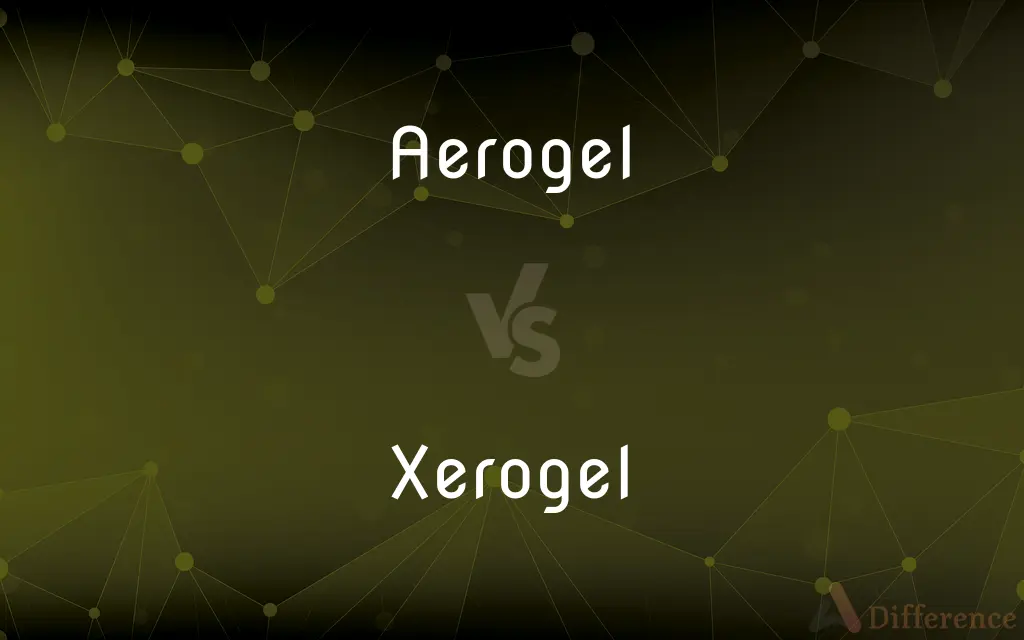Aerogel vs. Xerogel — What's the Difference?
Edited by Tayyaba Rehman — By Urooj Arif — Updated on March 21, 2024
Aerogel is an ultra-light material known for its low density and thermal insulation properties, made by replacing the liquid component of a gel with gas. Xerogel results from drying a gel to remove the liquid, leading to a more dense and solid.

Difference Between Aerogel and Xerogel
Table of Contents
ADVERTISEMENT
Key Differences
Aerogels are distinguished by their incredible lightness and thermal insulation capabilities, primarily due to their structure, which consists of a gel-like network filled with air. Xerogels, on the other hand, are formed through a conventional drying process that removes the liquid part of a gel, typically through evaporation.
The key difference between aerogels and xerogels lies in their drying process and the resultant physical structure. Aerogels maintain a highly porous and low-density structure, making them some of the lightest solid materials available. In contrast, xerogels undergo a shrinkage and densification process during drying, which results in a more solid and less porous material, albeit still useful for its surface properties and mechanical strength.
Despite their differences, both aerogels and xerogels share a common origin as gels. The transformation into either an aerogel or a xerogel depends on the method used to remove the liquid component. The choice between creating an aerogel or a xerogel depends on the desired material properties and application, with aerogels being preferred for uses that leverage their insulating properties and lightness, and xerogels being chosen for applications requiring greater mechanical strength and density.
While aerogels are celebrated for their extreme properties, such as thermal insulation and lightness, xerogels offer a balance of porosity and structural integrity, making them versatile for different applications. The development and use of both materials highlight the importance of material science in innovating solutions for a wide range of industrial, technological, and environmental challenges.
Comparison Chart
Density
Extremely low
Higher than aerogel, but still low
ADVERTISEMENT
Porosity
Very high, with up to 99% air
High, but less than aerogel
Manufacturing Process
Supercritical drying, avoiding collapse of the structure
Conventional drying, leading to some shrinkage
Properties
Excellent thermal insulation, transparency, lightness
Good porosity, solid structure, mechanical strength
Applications
Insulation, aerospace, high-performance clothing
Catalysts, drug delivery, desiccants
Compare with Definitions
Aerogel
Known for being one of the lightest solid substances.
Aerogel has been used in high-performance sporting goods for its lightness.
Xerogel
A porous solid formed by drying a gel.
Xerogel forms are used as catalyst supports in chemical reactions.
Aerogel
Made via supercritical drying to avoid structural collapse.
The production of aerogel involves removing liquid carbon dioxide under supercritical conditions.
Xerogel
Produced through conventional drying processes.
The creation of xerogel involves evaporating the solvent at atmospheric pressure.
Aerogel
An ultra-light material with exceptional insulation properties.
Silica aerogel is used in Mars rovers for thermal insulation.
Xerogel
Denser and less porous than aerogel.
Xerogel tiles are used in various filtration applications.
Aerogel
Highly porous, consisting mostly of air.
Aerogel's structure is so porous it's nearly transparent.
Xerogel
Retains a significant portion of the gel's network structure.
Silica xerogel is utilized in drug delivery systems for controlled release.
Aerogel
Utilized in environmental applications for oil spill cleanup.
Aerogel mats are effective in absorbing oil spills due to their high porosity.
Xerogel
Offers a balance of porosity and mechanical strength.
Xerogel coatings are applied in optics for their unique refractive properties.
Aerogel
Aerogels are a class of synthetic porous ultralight material derived from a gel, in which the liquid component for the gel has been replaced with a gas, without significant collapse of the gel structure. The result is a solid with extremely low density and extremely low thermal conductivity.
Xerogel
A solid formed by the dehydration of a gel
Aerogel
A highly porous solid formed from a gel, such as silica gel, in which the liquid is replaced with a gas.
Aerogel
A porous, ultralight solid-state substance, similar to gel, in which the liquid component is replaced with gas.
Common Curiosities
What makes aerogel so light?
Aerogel's extreme lightness results from its highly porous structure, which is up to 99% air.
What are the environmental applications of aerogels?
Aerogels are used in environmental cleanup, such as oil spill absorption, due to their high surface area and porosity.
Why is supercritical drying used for aerogels?
Supercritical drying is used to prevent the collapse of the gel's porous structure, maintaining the material's low density and high porosity.
Are xerogels always solid?
Yes, xerogels are solid materials, characterized by their retained gel network structure but with less porosity compared to aerogels.
What is the primary difference in the drying process of aerogels and xerogels?
The primary difference is that aerogels are dried using supercritical conditions to avoid pore collapse, while xerogels are dried more conventionally, often resulting in shrinkage.
Can both aerogels and xerogels be transparent?
While both can exhibit transparency, aerogels are more likely to be transparent due to their higher porosity and unique light transmission properties.
Why are aerogels considered better insulators than xerogels?
Aerogels have lower thermal conductivity due to their extremely low density and high air content, making them superior insulators.
Can xerogels be engineered to have specific properties?
Yes, xerogels can be engineered for specific applications by altering the gel precursor composition and drying process to adjust porosity, density, and mechanical strength.
Can xerogels be used for insulation?
While xerogels have insulating properties, they are generally not as effective as aerogels due to their higher density and lower porosity.
How do aerogels and xerogels compare in terms of cost?
Aerogels are generally more expensive to produce than xerogels due to the complex supercritical drying process required.
What advancements are being made in aerogel technology?
Advances in aerogel technology focus on reducing production costs, enhancing mechanical properties, and diversifying applications, such as in building insulation and lightweight batteries.
Share Your Discovery

Previous Comparison
Earmark vs. Bookmark
Next Comparison
Imbibe vs. InculcateAuthor Spotlight
Written by
Urooj ArifUrooj is a skilled content writer at Ask Difference, known for her exceptional ability to simplify complex topics into engaging and informative content. With a passion for research and a flair for clear, concise writing, she consistently delivers articles that resonate with our diverse audience.
Edited by
Tayyaba RehmanTayyaba Rehman is a distinguished writer, currently serving as a primary contributor to askdifference.com. As a researcher in semantics and etymology, Tayyaba's passion for the complexity of languages and their distinctions has found a perfect home on the platform. Tayyaba delves into the intricacies of language, distinguishing between commonly confused words and phrases, thereby providing clarity for readers worldwide.














































